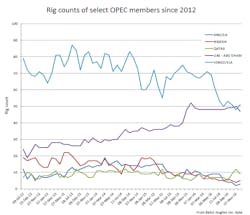The worldwide average of active rigs in November increased by 58 to 1,678 units, reflecting an ongoing drilling rebound in the US and Canada, according to data from Baker Hughes Inc. (OGJ Online, Nov. 7, 2016). The latest tally is down 369 year-over-year.
Most of the increase came in the US, where an average 36 units started operations to bring the country to 580, down 180 compared with its November 2015 average (OGJ Online, Dec. 2, 2016). Canada contributed a 17-unit increase and averaged 173, down just 5 year-over-year.
Beyond North America, the North Sea received some extra attention in November as Europe recorded its largest monthly increase since March 2014, gaining 9 offshore units and 10 overall to 97, down 11 year-over-year.
Regional petroleum powerhouse Norway led the way with a 6-unit rise to 15, up 1 year-over-year. The UK sector of the North Sea rose 3 units to 10, down 2 year-over-year. Germany’s rig count doubled to 4. Turkey dropped 2 units to 29.
The Asia-Pacific region rose 6 units during the month to 188, down 20 compared with its November 2015 average. India jumped 5 units to 117, up 12 year-over-year. Vietnam doubled to 4 and Papua New Guinea gained 2 units to 3. Indonesia fell 3 units to 14, down 10 year-over-year.
Africa in November increased 2 units to 79, down 11 year-over-year. Nigeria, Angola, and Congo (Brazzaville) each added a unit to average 5, 3, and 3, respectively. Ivory Coast dropped its only active rig.
Latin America dropped 2 units during the month to 181, down 103 compared with its November 2015 average. Brazil lost 4 units to 10, down 26 year-over-year. Mexico fell 3 units to 18, down 20 year-over-year. Colombia, meanwhile, jumped 5 units to 16, up 1 year-over-year. Venezuela gained 3 units to 51, down 19 year-over-year.
In the Middle East, where the region’s top producers closed the month by reaching an agreement with other members of the Organization of Petroleum Exporting Countries to curtail future output, the average November rig count declined 11 units to 380, down 39 year-over-year.
The drop in the region’s monthly tally was shouldered by non-OPEC Oman, and OPEC-encompassed Abu Dhabi and Qatar, each of which fell 3 units to 61, 47, and 9, respectively.
Contact Matt Zborowski at [email protected].
